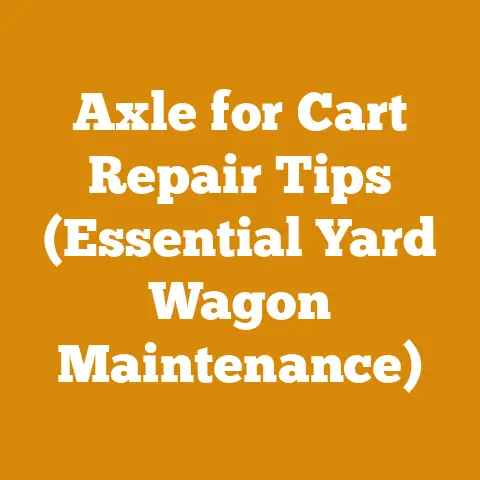Poulan Pro 330 Chainsaw Tips (5 Expert Maintenance Tricks)
Let’s bust a myth right off the bat: You don’t need to be a professional logger to keep your Poulan Pro 330 chainsaw running like a champ. Many folks think chainsaw maintenance is some mystical art reserved for the pros, but I’m here to tell you that with a few simple tricks, anyone can keep their saw in tip-top shape. I’ve spent years felling trees and prepping firewood, and I’ve learned a thing or two about chainsaw maintenance along the way. The Poulan Pro 330 is a solid workhorse, but like any machine, it needs a little TLC to keep it humming. So, let’s dive into my top 5 expert maintenance tricks for your Poulan Pro 330 chainsaw.
Poulan Pro 330 Chainsaw Tips (5 Expert Maintenance Tricks)
1. The Fuel Factor: Keeping Your Poulan Pro 330 Gassed Up Right
Fuel is the lifeblood of your Poulan Pro 330. But it’s not just about pouring any old gas into the tank. I’ve seen countless saws rendered useless because of improper fuel mixtures.
The Right Mix:
- The Ratio: Your Poulan Pro 330, like most two-stroke engines, requires a specific fuel-to-oil ratio. This is typically 40:1. That means 40 parts gasoline to 1 part two-stroke oil.
- The Oil: Don’t skimp on the oil! Use a high-quality, two-stroke oil specifically formulated for air-cooled engines. I prefer synthetic oils because they provide better lubrication and burn cleaner, reducing carbon buildup.
- The Gasoline: Use fresh, unleaded gasoline with an octane rating of 87 or higher. Avoid using gasoline that has been sitting around for more than 30 days, as it can degrade and cause starting problems. Ethanol blends (E10) are generally okay, but if you’re storing your saw for an extended period, use ethanol-free gasoline to prevent fuel system issues.
Mixing Like a Pro:
- Use a Clean Container: Always mix your fuel in a clean, approved fuel container. This prevents contamination and ensures an accurate mixture.
- Start with Oil: Pour the correct amount of two-stroke oil into the container first. This helps ensure the oil mixes thoroughly with the gasoline.
- Add Gasoline: Add the gasoline to the container, carefully measuring to maintain the 40:1 ratio.
- Shake Well: Secure the lid on the container and shake vigorously for at least 30 seconds to ensure the oil and gasoline are thoroughly mixed.
My Personal Experience:
I once had a Poulan Pro 330 that refused to start. After checking everything else, I realized I had used old, stale gasoline. The fuel had degraded, and the engine wouldn’t fire. Lesson learned: fresh fuel is crucial!
Takeaway: Use the correct fuel-to-oil ratio (40:1), high-quality two-stroke oil, and fresh gasoline. Always mix your fuel properly in a clean container.
2. Chain Champions: Sharpening and Maintaining Your Poulan Pro 330’s Cutting Edge
A dull chain is not only inefficient; it’s also dangerous. You’ll be forcing the saw, increasing the risk of kickback and putting unnecessary strain on the engine. I’ve witnessed firsthand how a sharp chain can make all the difference between a smooth, controlled cut and a frustrating, potentially hazardous experience.
Sharpening Essentials:
- The Right Tools: You’ll need a chainsaw file, a file guide, a depth gauge tool, and a vise to hold the chain securely. The file size depends on the chain pitch of your Poulan Pro 330. Consult your owner’s manual for the correct file size.
- The Angle: Maintaining the correct filing angle is crucial for effective sharpening. Use a file guide to ensure you’re filing at the proper angle (typically around 30 degrees).
- The Depth Gauges: Check the depth gauges regularly. These small metal tabs in front of each cutting tooth control how much wood the tooth can bite into. If the depth gauges are too high, the chain won’t cut effectively. Use a depth gauge tool to file them down to the correct height.
Sharpening Step-by-Step:
- Secure the Chain: Place your chainsaw in a vise to hold the chain securely.
- Identify the Sharpest Tooth: Choose the sharpest tooth on the chain as your guide.
- File Each Tooth: Using the file and file guide, file each tooth with smooth, even strokes. File from the inside of the tooth outwards, following the original angle of the cutting edge.
- Maintain Consistency: Count the number of strokes you make on each tooth and apply the same number of strokes to all the other teeth to ensure consistent sharpening.
- Check Depth Gauges: Use a depth gauge tool to check the height of the depth gauges. File them down if necessary, following the tool’s instructions.
Chain Maintenance Beyond Sharpening:
- Chain Tension: Check the chain tension regularly. The chain should be snug on the bar but still able to be pulled around by hand. Too loose, and it can derail. Too tight, and it can bind and overheat.
- Chain Lubrication: Ensure the chain is properly lubricated. The Poulan Pro 330 has an automatic oiler, but you should still check the oil level regularly and make sure the oiler is functioning correctly. I recommend using a high-quality bar and chain oil.
- Chain Cleaning: After each use, clean the chain with a brush and solvent to remove sawdust and debris. This will help prevent rust and corrosion.
Case Study:
I worked on a logging project where we were felling large oak trees. One of the crew members was constantly struggling with his chainsaw, while I was effortlessly cutting through the same trees. The difference? He wasn’t sharpening his chain properly. After showing him the proper technique, his cutting speed and efficiency dramatically improved.
Takeaway: Sharpen your chain regularly using the correct tools and techniques. Maintain proper chain tension, lubrication, and cleanliness.
3. Air Apparent: Cleaning and Maintaining Your Poulan Pro 330’s Air Filter
The air filter is your Poulan Pro 330’s first line of defense against dirt, dust, and debris. A clogged air filter restricts airflow to the engine, causing it to run poorly, lose power, and potentially overheat. I’ve seen saws with air filters so clogged they looked like they were made of felt!
Why Clean the Air Filter?
- Improved Performance: A clean air filter allows the engine to breathe properly, resulting in optimal performance and fuel efficiency.
- Extended Engine Life: A clean air filter prevents dirt and debris from entering the engine, reducing wear and tear on critical components.
- Easier Starting: A clogged air filter can make it difficult to start the engine.
Cleaning Procedure:
- Locate the Air Filter: The air filter is typically located under a cover on the top or side of the engine. Consult your owner’s manual for the exact location.
- Remove the Air Filter: Carefully remove the air filter from its housing.
- Clean the Air Filter: There are two main types of air filters: foam and paper.
- Foam Filters: Wash the foam filter with warm, soapy water. Rinse thoroughly and allow it to air dry completely. Once dry, lightly oil the filter with air filter oil.
- Paper Filters: Tap the paper filter gently to remove loose dirt and debris. If the filter is heavily soiled, replace it with a new one. I don’t recommend washing paper filters, as this can damage the filter material.
- Clean the Air Filter Housing: Use a brush or cloth to clean the air filter housing, removing any dirt or debris.
- Reinstall the Air Filter: Carefully reinstall the air filter into its housing, ensuring it is properly seated.
Frequency of Cleaning:
How often you need to clean the air filter depends on the conditions in which you’re using the saw. If you’re working in dusty environments, you’ll need to clean it more frequently. I recommend checking the air filter after each use and cleaning it as needed.
Pro Tip:
I always keep a spare air filter on hand. This allows me to quickly replace a dirty filter without having to wait for it to dry.
Takeaway: Clean or replace your air filter regularly to ensure optimal engine performance and longevity.
4. Spark Plug Secrets: Inspecting and Maintaining Your Poulan Pro 330’s Ignition System
The spark plug is the unsung hero of your Poulan Pro 330’s engine. It’s responsible for igniting the fuel-air mixture, creating the combustion that powers the saw. A faulty spark plug can cause hard starting, misfires, and poor performance. I’ve seen saws that were completely dead simply because of a fouled spark plug.
Spark Plug Inspection:
- Location: The spark plug is typically located on the side of the engine, near the cylinder head.
- Removal: Use a spark plug wrench to carefully remove the spark plug.
- Inspection: Inspect the spark plug for signs of wear, damage, or fouling.
- Electrode Condition: The electrode should be clean and have a sharp edge. If the electrode is rounded or worn, the spark plug should be replaced.
- Insulator Condition: The insulator (the white ceramic part) should be clean and free of cracks or chips. If the insulator is damaged, the spark plug should be replaced.
- Fouling: Check for carbon buildup, oil, or fuel on the electrode and insulator. If the spark plug is fouled, clean it with a wire brush or replace it.
Spark Plug Cleaning:
If the spark plug is only slightly fouled, you can try cleaning it with a wire brush. Be careful not to damage the electrode or insulator.
Spark Plug Replacement:
If the spark plug is heavily fouled, damaged, or worn, it should be replaced. Use the correct spark plug for your Poulan Pro 330. Consult your owner’s manual for the correct spark plug number.
Spark Plug Gap:
The spark plug gap is the distance between the electrode and the ground electrode. The correct spark plug gap is crucial for proper ignition. Consult your owner’s manual for the correct spark plug gap for your Poulan Pro 330. Use a spark plug gap tool to adjust the gap if necessary.
My Experience:
I was once working on a project in the middle of the woods when my Poulan Pro 330 suddenly died. After checking everything else, I realized the spark plug was completely fouled. Luckily, I had a spare spark plug with me, and after replacing it, the saw started right up.
Takeaway: Inspect your spark plug regularly for signs of wear, damage, or fouling. Clean or replace the spark plug as needed, and always use the correct spark plug gap.
5. Bar Basics: Maintaining Your Poulan Pro 330’s Guide Bar
The guide bar is the metal rail that the chain rides on. It’s a critical component of your Poulan Pro 330, and proper maintenance is essential for smooth and efficient cutting. I’ve seen countless bars worn out prematurely due to neglect.
Bar Maintenance:
- Cleaning: After each use, clean the guide bar with a brush and solvent to remove sawdust and debris. Pay particular attention to the groove that the chain rides in.
- Filing: Check the guide bar for burrs or damage along the edges. Use a flat file to remove any burrs or smooth out any rough spots.
- Lubrication: Ensure the guide bar is properly lubricated. The Poulan Pro 330 has an automatic oiler, but you should still check the oil level regularly and make sure the oiler is functioning correctly. I recommend using a high-quality bar and chain oil.
- Bar Rails: The bar rails are the surfaces that the chain rides on. Over time, these rails can wear down unevenly. To prolong the life of your guide bar, flip it over periodically. This will distribute the wear evenly.
- Bar Straightness: Check the guide bar for straightness. A bent or warped guide bar can cause the chain to bind and overheat. If the guide bar is bent, it should be replaced.
- Oiling Holes: Make sure the oiling holes are clear of debris. These holes allow oil to flow from the oiler to the chain. Use a small wire or needle to clean out any clogged oiling holes.
When to Replace the Guide Bar:
- Excessive Wear: If the bar rails are excessively worn, the guide bar should be replaced.
- Damage: If the guide bar is bent, cracked, or otherwise damaged, it should be replaced.
- Inability to Maintain Proper Chain Tension: If you can no longer maintain proper chain tension, the guide bar may be worn out and need to be replaced.
Real-World Example:
I was working with a crew clearing brush when one of the guys started complaining about his chainsaw cutting crooked. After inspecting his saw, I noticed that his guide bar was bent. He had likely hit a rock or other hard object. After replacing the guide bar, his saw cut straight as an arrow.
Takeaway: Clean, file, and lubricate your guide bar regularly. Flip the bar over periodically to distribute wear evenly. Replace the guide bar when it is excessively worn, damaged, or bent.
By following these 5 expert maintenance tricks, you can keep your Poulan Pro 330 chainsaw running smoothly and efficiently for years to come. Remember, a little maintenance goes a long way! I hope these tips help you get the most out of your chainsaw and make your wood processing tasks safer and more enjoyable. Happy cutting!






